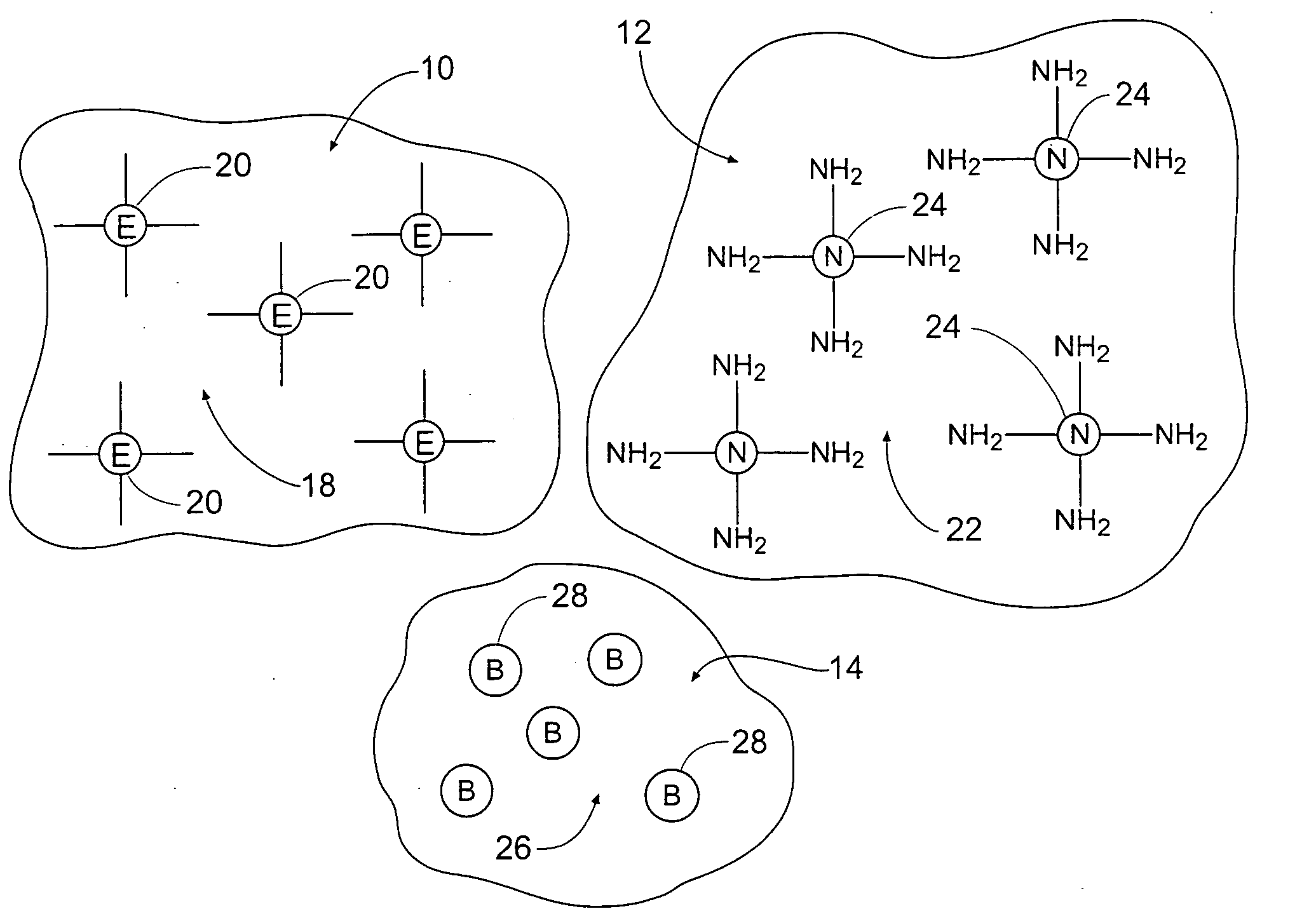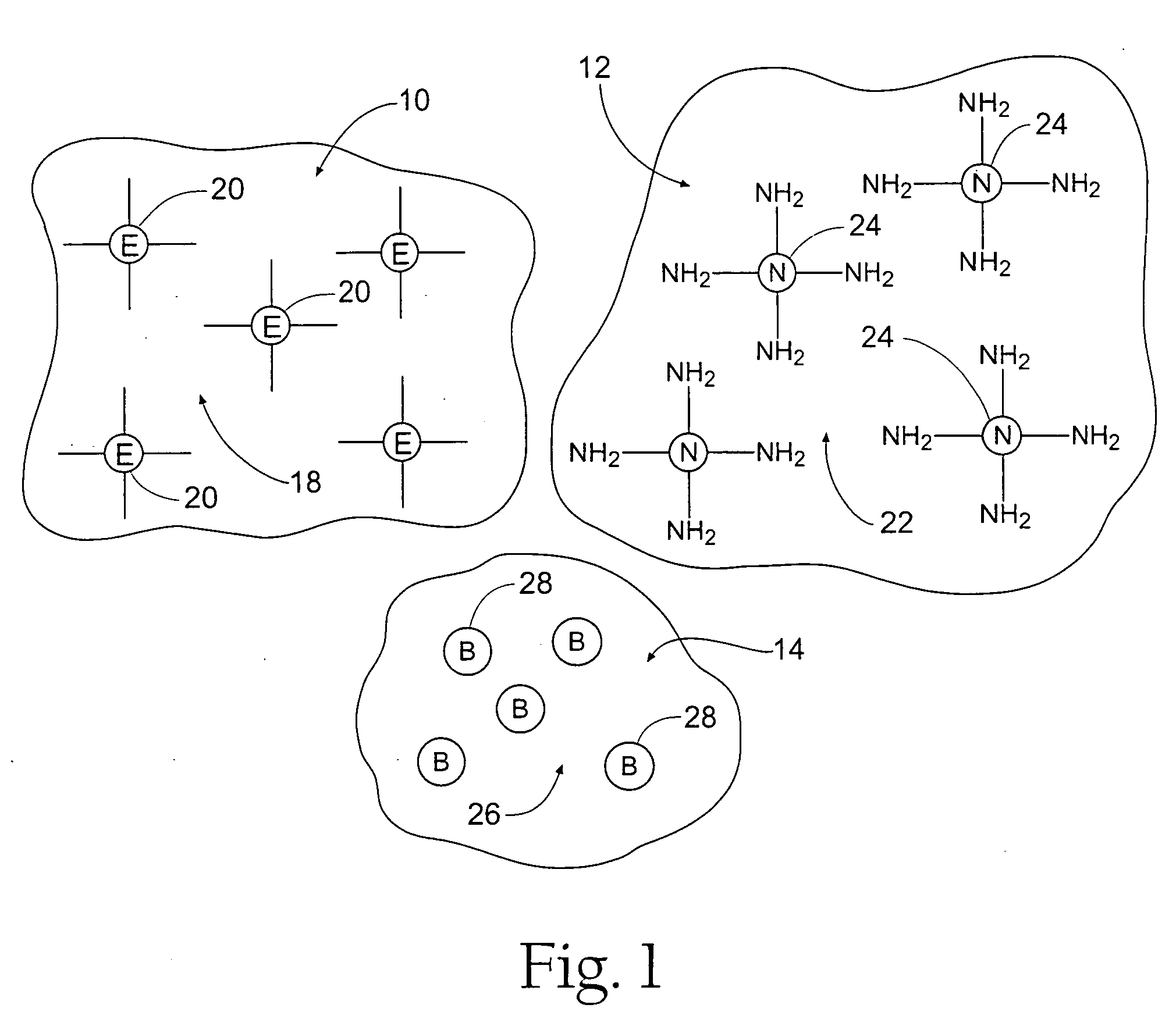Tissue adhering compositions
a composition and tissue technology, applied in the field of tissue adhering compositions, can solve the problems of incongruent management goals, excessive use and cost of health care personnel, and incongruent technique, cost efficiency, or efficacy, or combinations,
- Summary
- Abstract
- Description
- Claims
- Application Information
AI Technical Summary
Benefits of technology
Problems solved by technology
Method used
Image
Examples
example 1
Sodium Carbonate / Sodium Phosphate Buffer Formulations
[0072] Albumin (Human 25%, Plasbumin®-25 manufactured by Bayer Corporation) was buffered using differing amounts of Sodium Carbonate Monohydrate (Na2CO3H2O) (FW 124.00) (“Carbonate Buffer”) and Sodium Phosphate Monobasic Monohydrate (NaH2PO4H2O) (FW 137.99) (“Phosphate Buffer”). The buffered albumin formulations (2 cc) were mixed with 2 cc of the Shearwater PEG (0.45 g of PEG suspended in 2.2 cc of water), to provide 17% w / w PEG solids. The components were mixed by using the catheter device as generally shown in FIG. 2 (and as will be described in greater detail later). Upon mixing, the components were deposited in a test dish. The pH of the buffered albumin formulation (albumin plus buffer material) and the gelation time (as described above) and were recorded.
[0073] Table 1 summarizes the results.
TABLE 1Albumin(HumanCarbonatePhosphateDeviceGelling25%)BufferBuffer(OutsideTime(ml)(grams)(grams)pHDiameter)(Seconds)500.3750.2758....
example 2
Carbonate Buffer / Tris Buffer Formulations
[0075] Albumin (Human 25%, Plasbumin®-25 manufactured by Bayer Corporation) was buffered using Sodium Carbonate Anhydrous (Na2CO3) (FW 106.0) (“Carbonate Buffer”) mixed with Tris-hydroxymethylaminomethane (C4H11NO3) (FW 121.1) (“Tris Buffer”). The buffered albumin formulations (2 cc) were mixed with 2 cc of the Shearwater PEG (0.45 g of PEG suspended in 2.2 cc of water), to provide 17% w / w PEG solids, in the same manner as Example 1. The pH of the buffered albumin formulation (albumin plus buffer material) and the gelation time (as described above) and were recorded.
[0076] Table 2 summarizes the results.
TABLE 2Albumin(HumanCarbonateTrisDeviceGelling25%)BufferBuffer(OutsideTime(ml)(grams)(grams)pHDiameter)(Seconds)200.1370.1459.08 Fr15-16200.1370.1459.08 Fr15-16
[0077] Table 2 shows faster gelation times, compared to the gelation times in Table 1, despite the presence of less Carbonate Buffer (pK 10). The more rapid gelling times are due to...
example 3
Carbonate Buffer / Tris Buffer Formulations
[0078] Albumin (Human 25%, Plasbumin®-25 manufactured by Bayer Corporation) was buffered using Sodium Carbonate Anhydrous (Na2CO3) (FW 106.0) (“Carbonate Buffer”) mixed with Tris-hydroxymethylaminomethane (C4H11NO3) (FW 121.1) (“Tris Buffer”). The buffered albumin formulations (2 cc) were mixed with 2 cc of the SunBio PEG (0.45 g of PEG suspended in 2.2 cc of water), to provide 17% w / w PEG solids. The components were mixed in the manner described in Example 1. The pH of the buffered albumin formulation (albumin plus buffer material) and the gelation time (as described above) and were recorded.
[0079] Table 3 summarizes the results.
TABLE 3Albumin(HumanCarbonateTrisDeviceGelling25%)BufferBuffer(OutsideTime(ml)(grams)(grams)pHDiameter)(Seconds)2000.2178.37 Fr112000.2908.57 Fr7-8200.0750.1458.77 Fr5-6200.1380.1459.07 Fr2-3
[0080] Table 3 shows even faster gelation times, compared to the gelation times in Tables 1 and 2, at lower pH's. This is b...
PUM
 Login to View More
Login to View More Abstract
Description
Claims
Application Information
 Login to View More
Login to View More - R&D
- Intellectual Property
- Life Sciences
- Materials
- Tech Scout
- Unparalleled Data Quality
- Higher Quality Content
- 60% Fewer Hallucinations
Browse by: Latest US Patents, China's latest patents, Technical Efficacy Thesaurus, Application Domain, Technology Topic, Popular Technical Reports.
© 2025 PatSnap. All rights reserved.Legal|Privacy policy|Modern Slavery Act Transparency Statement|Sitemap|About US| Contact US: help@patsnap.com



